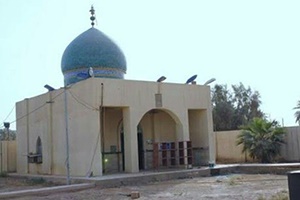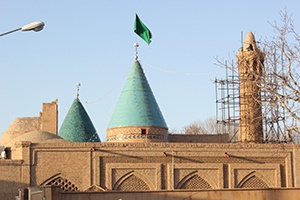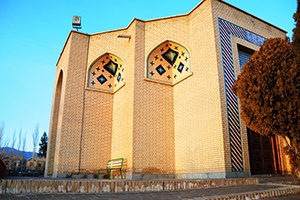Mahan Air Airline, Arrival at Tehran Airport
- W5082 (International) - Kuala lumpur / Tehran
Departure: 23:30
Arrival: 03:30 (+1)
- W5083 (International) - Tehran / Kuala lumpur
Departure: 21:55
Arrival: 10:20 (+1)
Day 1: Tehran
Meet and greet at the IKA airport with our professional tour guide then, transfer to IBIS Hotel which is located next to IKA Airport, to pray and have breakfast then before checking in Hotel, you can visit
- Holy Shrine of Imam Khomeini
The mausoleum of Ayatollah Ruhollah Khomeini, easily reached via metro, is one the grandest architectural endeavors of the Islamic Republic. Built on an enormous scale – which necessitated the moving of many existing graves at the giant Behesht-e Zahra cemetery – the Holy Shrine also contains the tombs of Khomeini's wife, second son and several other important political figures; in 2017, former president Akbar Rafsanjani was buried here. The shrine is flanked by four 91m-high towers symbolizing Khomeini’s age when he died. The huge gold central dome is adorned with 72 tulips, which symbolize the 72 martyrs who fought and died with Imam Hossein in Karbala.
- Azadi tower
Formerly known as the shahyad Tower and is one of the landmarks of Tehran. It is about 148 ft. tall and is completely clad in cut marble.
- Nature Bridge
The Tabi'at Bridge or Nature Bridge, is the largest pedestrian overpass built in Tehran, Iran. The 270-metre bridge connects two public parks—Taleghani Park and Abo-Atash Park—by spanning Modarres Expressway, one of the main highways in northern Tehran.
O/N Tehran Day 2: Tehran
City Tour will Start with National Museum
- National Museum
The National Museum of Iran is located in Tehran. It is an institution formed of two complexes; the Museum of Ancient Iran and the Museum of the Islamic Era, which were opened in 1937 and 1972, respectively. The institution hosts historical monuments dating back through preserved ancient and medieval Iranian antiquities, including pottery vessels, metal objects, textile remains, and some rare books and coins.
- Golestan palace
One of the oldest historic monuments in the city of Tehran, and of world heritage status, the Golestan Palace belongs to a group of royal buildings that were once enclosed within the mud-thatched walls of Tehran's arg ("citadel"). It consists of gardens, royal buildings, and collections of Iranian crafts and European presents from the 18th and 19th centuries.
- Grand Bazaar
The maze of bustling alleys and the bazar is (shopkeepers) that fill them make this a fascinating, if somewhat daunting, a place to explore. Despite being known as the Grand Bazaar, most of the architecture is less than 200 years old and pedestrian, although there are some gems to be found.
O/N Tehran Day 3: Tehran – Mashhad
Early Morning, transfer to Mehrabad Airport for the Domestic flight to Mashhad, and the group has an excursion to Tus City before Check in Hotel
- Sheykh Abu Ali Farmadi
Abu Ali al-Farmadi (may God sanctify his innermost being), the eighth Shaykh in the Naqshbandi Golden Chain, was born in 1016 A.D. in the village of Farmad, near Tus in modern day Iran. He was a scholar in the Shafi school of Islamic jurisprudence, an expert in the knowledge of the early Islamic scholars and a Master of Sufism. Shaykh Abu Ali received the secrets of the Golden Chain from Shaykh Abul Hasan al-Kharqani.
- Sheykh Imam AL–Ghazali
was one of the most prominent and influential philosophers, theologians, jurists, and mystics of Sunni Islam. He was of Persian origin. Islamic tradition considers him to be a Mujaddid, a renewer of the faith who, according to the prophetic hadith, appears once every century to restore the faith of the ummah ("the Islamic Community"). His works were so highly acclaimed by his contemporaries that al-Ghazali was awarded the honorific title "Proof of Islam" (Hujjat al-Islam). Al-Ghazali also played a major role in integrating Sufism with Shariah. He was also the first to present a formal description of Sufism in his works. His works also strengthened the status of Sunni Islam against other schools. The Batinite (Ismailism) had emerged in Persian territories and were gaining more and more power during al-Ghazali's period, as Nizam al-Mulk was assassinated by the members of Ismailis. Al-Ghazali strongly rejected their ideology and wrote several books on criticism of Baatinyas which significantly weakened their status.
O/N Mashhad  Sheykh Imam AL–Ghazali
Sheykh Imam AL–GhazaliDay 4: Mashhad – Shahrood
After breakfast, Drive to Shahroud, On the way visit some Attractions
- Holy Shrine of Imam Reza
Ali ibn Moosa (Ali the son of Moosa) known as Reza is of descendants of Muhammad, the holy prophet of Islam, cherished by the Muslims of the whole world for his high spiritual levels and importance whom born in Medina and moved to Thus in Iran after the order of Ma'mūn, the seventh Abbasid caliph, when the most significance part of Imam Reza’s life regarding his political and religious role initiates and conclude by his martyrization.
- Bazaar Reza
Mashhad is the saffron-centre of the world, and you won’t get a better deal anywhere else than in the bazaars around Falakeh Ab square. The spice, which is gram-for-gram more expensive than gold, makes for an excellent souvenir or present. Mashhadi carpets are also particularly revered, so be prepared to haggle your way to a good price. Pilgrimage memorabilia lines the streets too, having your portrait superimposed in front of the Imam’s shrine is an especially quirky crowd favorite.
- Tomb of Attar
Farīd ud-Dīn Attar Neyshaburi, well-known Iranian poet and mystic, was born in 1145 AD and passed away in 1221 AD. His mausoleum is located on Erfan Street in current Nishapur and hosts people interested in Iranian literature and culture every year. His famous works are "The Conference of the Birds" and "Tazkirat al-Awliyā". Attar's initiation into Sufi practices is subject to much speculation. Of all the famous Sufi Shaykhs supposed to have been his teachers, only one - Majd ud-Din Baghdadi a disciple of Najmuddin Kubra- comes within the bounds of possibility. The only certainty in this regard is `Attar's own statement that he once met him.[9] In any case it can be taken for granted that from childhood onward `Attar, encouraged by his father, was interested in the Sufis and their sayings and way of life, and regarded their saints as his spiritual guides.
- Tomb of Khayam
Iranian philosopher, astrologist, astronomer, mathematician, and quatrain poet, Khayyam lived a simple and full of knowledge life as well as isolation during his 70-year life. There is a tradition of attributing poetry to Omar Khayyam, written in the form of quatrains (rubāʿiyāt ). This poetry became widely known to the English-reading world in a translation by Edward FitzGerald (Rubaiyat of Omar Khayyam, 1859), which enjoyed great success in the Orientalism of the fin de siècle. The Mausoleum of Khayyam is one of the most important buildings of that period in terms of creativity, construction, and architecture.
O/N Shahroud Day 5: Shahrood
The Group has full day City Tour
- Tomb of Sheykh Abu Yazid Bistami
commonly known in the Iranian world as Bāyazīd Bisṭāmī. He was a Persian Sufi, from north-central Iran. Known to future Sufis as Sultān-ul-Ārifīn ("King of the Gnostics"). Bisṭāmī is considered to be one of the pioneers of the concept of fanā, the notion of passing away in mystical union with the deity. Bastami, who was famous for "the boldness of his expression of the mystic’s complete absorption into the Godhead, Many ecstatic utterances (shathiyāt) have been attributed to Bisṭāmī, which lead to him being known as the "drunken" or "ecstatic" (sukr) school of Islamic mysticism.
- Tomb of Shyekh Abu Hasan Kharaaqan
He is one of the masters Sufis of Islam. He was born in 963 (352 Hijri year) from persian parents in Khorasan in a village called Kharaqan (today located in Semnan Province, Iran near Bastam). Attar of Nishapur, a famous Persian poet and Sufi, devoted a large part of his book Tadhkiratul-Awliya (Biography of the Saints) about the personality, state and stories of Kharaqani. Attar has called him as Sultān-e Salāteen-e Mashāyekh (The King of the kings of Sufi Masters), Ocean of the spiritual knowledge, Sun of the Lord, Mystery of the Lord and Qibla (focus of attention) of his people.
O/N Shahroud  Tomb of Sheykh Abu Yazid Bistami
Tomb of Sheykh Abu Yazid Bistami  Tomb of Shyekh Abu Hasan Kharaaqan
Tomb of Shyekh Abu Hasan KharaaqanDay 6: Shahrood – Yazd
After breakfast, Drive to Yazd, on the way visiting
- Tarikhaneh Temple
also called the Tarikhaneh Mosque, is a Sassanid-eramonument located on the southern limit of the present day city of Damghan. This structure was initially used as a Zoroastrian Fire Temple during the Sassanid period, however, after the fall of the Sassanid Empire it was converted into a mosque in the 8th century. The monument is, thus, known as the oldest extant mosque in Iran. Tari is the Turkic term for God, and Khaneh is a Persian word meaning house. Therefore, the compound word Tarikhaneh, translates into "the house of God".
- Tappe Hisar of Damghan
It is located near Damghan and it is one of the important ancient hills of Iran plateau.The site is notable for its uninterrupted occupational history from the 5th to the 2nd millennium BCE. The quantity and elaborateness of its excavated artifacts and funerary customs position the site prominently as a cultural bridge between Mesopotamia and Central Asia. The historical area of Tappeh Hesar is approximately 160 hectares.
- Chak Chak Temple
It is the most sacred of the Zoroastrians mountain shrines. Located near the city of Ardakan in Yazd province, Chak Chak serves as a pilgrimage point for pious Zoroastrians. Each year in June thousands of Zoroastrians from Iran, India and other countries flock to the fire temple of Pir’e Sabz. Tradition has it that pilgrims are to stop the moment they see the sight of the temple and continue their journey on foot the rest of the way. Once there they light candles in line with the Zoroastrian belief that fire symbolises God's light and under the credo of "good thoughts, good speech, good deeds".
O/N Yazd Day 7: Yazd
The group has Full day City Tour
- Dolatabad Garden
This garden is one of the Iranian gardens registered in UNESCO, and also Badgir (wind Catcher) inside the garden is the tallest brick one in the world.
- Zoroastrian fire temple
The Local Cellar is that the Zoroastrians from late to 40 years ago, their Dead in accordance with Culture and Customs and during special ceremonies Entered the Cellar
- Takhtei’s Zoorkhane
Pahlavevani is an Iranian material art that combines elements of Islam, Gnosticism and ancient Persian beliefs.it describes a ritual collection of gymnastic and callisthenic movement performed by ten to twenty men, each wielding instruments symbolizing ancient weapons.it is part of the spiritual effects of Iran, which has been recorded by UNESCO.
- Tower of silence
A Dakhma also called a Tower of Silence, is a circular, raised structure built by Zoroastrians for excarnation – that is, for dead bodies to be exposed to carrion birds, usually vultures. Zoroastrian tradition considers a dead body (in addition to cut hair and nail parings) to be nasu, unclean, i.e. potential pollutants. Specifically, the corpse demon (Avestan: nasu.daeva) was believed to rush into the body and contaminate everything it came into contact with, hence the Vendidad (an ecclesiastical code "given against the demons") has rules for disposing of the dead as safely as possible.
O/N Yazd Day 8: Yazd – Isfahan
After breakfast, Drive to Isfahan, On the way visiting
- Narin Castle
The Narin Qal'eh or Narin Castle is a mud-brick fort or castle in the town of Meybod, Iran. Structures like these constituted the government stronghold in some of the older (pre-Islamic) towns of central Iran. Some of these castles incorporate mud bricks of the Medes period and of the Achaemenid and Sassanid dynasties.
- Nagsh-e Jahan square
Naqsh-e Jahan Square, is a square situated at the centre of Isfahan city, Iran. Constructed between 1598 and 1629, it is now an important historical site, and one of UNESCO's World Heritage Sites. It is 160 metres wide by 560 metres long.
- Imam Mosque
The Shah Mosque, also known as Royal Mosque or Imam Mosque after Iranian revolution, is a mosque in Isfahan, Iran, standing in south side of Naghsh-e Jahan Square. Built during the Safavid Empire, ordered by Abbas I of Persia.
- Aali Qapoo Palace
Built at the very end of the 16th century as a residence for Shah Abbas I, this six-storey palace also served as a monumental gateway to the royal palaces that lay in the parklands beyond (Aali Qapu means ‘Gate of Ali’). Named after Abbas ’hero, the Imam Ali, it was built to make an impression, and at six stores and 38m tall, with its impressive elevated terrace featuring 18 slender columns, it dominates one side of Naqsh-e Jahan (Imam) Squr.
- Sheikh Lotf Allah Mosque
Sheikh Lotfollah Mosque is one of the architectural masterpieces of Iranian architecture that was built during the Safavid Empire, standing on the eastern side of Naghsh-e Jahan Square, Esfahan, Iran.
- Bazaar
The Grand Bazaar is a historical market located in Isfahan, Iran, also known as "Qeysarriyeh Bazaar"
- Sio-se-Pol Bridge
The Allah Verdi Khan Bridge, popularly known as Si-o-se-pol, is one of the eleven bridges in Isfahan, Iran.
O/N Isfahan Day 9: Isfahan – IKA
The group will transfer early in the morning to IKA Airport to fly back home, on the way visiting
- Chehel Sotoun Palace
is a pavilion in the middle of a park at the far end of a long pool, in Isfahan, Iran, built by Shah Abbas II to be used for his entertainment and receptions. In this palace, Shah Abbas II and his successors would receive dignitaries and ambassadors, either on the terrace or in one of the stately reception halls. The name, meaning "Forty Columns" in Persian, was inspired by the twenty slender wooden columns supporting the entrance pavilion, which, when reflected in the waters of the fountain, are said to appear to be forty.
- Fin’s garden
: The Fin’s garden is an example of Iranian gardens named after the UNESCO world heritage list. The garden covers 2.3 hectares with a main yard surrounded by ramparts with four circular towers. In keeping with many of the Persian gardens of this era, the Fin Garden employs a great many water features. These were fed from a spring on a hillside behind the garden, and the water pressure was such that a large number of circulating pools and fountains could be constructed without the need for mechanical pumps. The garden contains numerous cypress trees and combines architectural features of the Safavid, Zandiyeh and Qajar periods.
- Underground Noushabad city
The underground city of Ouyi (Noushabad), located 5km north of Kashan, Isfahan province, is considered a notable piece of ancient architecture. As Noushabad city is located in the central desert region of Iran, it experiences harsh weather. During the day, Noushabad has a very hot temperature and during the nights it gets notably cold.
Mahan Air Airline, Departure from IKA to KLIA Airport ACCOMODATION | City | Hotel | Night |
| Tehran | Esteghlal West Tower or other 4* hotel | 2 |
| Mashhad | Tara or other 4* Hotel | 1 |
| Shahroud | Paramida 4* Hotel (apartment) | 2 |
| Yazd | Moshir Garden or other 4* hotel | 2 |
| Isfahan | Khajoo or other 4* Hotel | 1 |